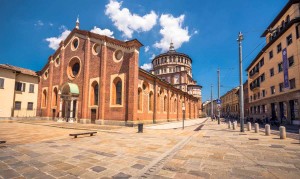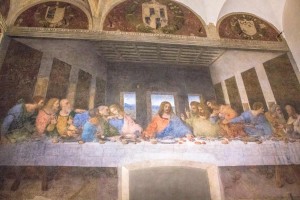Milan, Italy’s second-largest city and regional capital of Lombardy. 1.3 million people live here, surrounded by palpable history, fashion hotspots and two of the most famous football clubs in the world. AC or Inter – for many Milanese, it’s a matter of conviction. Other topics, however, tend to, unite people, such as naming the Dominican church Santa Maria delle Grazie as one of the most beautiful buildings of the city, maybe even its most beautiful. It attracts tourists from across the globe who simply cannot resist the unique charm of this UNESCO World Heritage Site. Most certainly, this has to do with one of the most famous works of art in the world – “The Last Supper” by Leonardo da Vinci.
Construction history

©Bigstock.com/Georgios Tsichlis
A small chapel dedicated to the Virgin Mary was originally situated where the world-famous church now stands. Francesco I Sforza, Duke of Milan, desired a Dominican convent with church and ordered Guiniforte Solari, architect of the current main university building Ospedale Maggiore and construction supervisor of the Duomo, to construct those very buildings in Gothic style.
After the convent (1469) and the church (1490) had been finished, Ludovico Sforza decided to use the church as the family burial site, which required sufficient reconstruction works. The choir with its crossing was torn down and rebuilt as a monumental centrally-planned building in the then popular Renaissance style after plans by Donato Bramante. However, Sforza’s plans were never fully realised. After his fall, the original Gothic nave remained the same. Santa Maria delle Grazie only opened its gates in the 1520s with Ludovico’s wife Beatrice d’Este being the first person buried in the new choir.
Stylistic plurality between Gothic and Renaissance
Two different construction eras left very special, unusual marks on the Dominican church; marks you can clearly see to this very day. The Gothic and the Renaissance part can be told apart rather neatly, both outside and inside Santa Maria delle Grazie. The nave with rather wide supports shows distinct characteristics of the Lombard redbrick Gothic period. Other characteristics of this architectural era are the use of a staggered hall, the cambered nave and the gradation of the roof, which can only be slightly seen from the outside. The wall paintings dating back to 1482 to 1485 are mostly true-to-original, too, as they were only laid open in the 1930s.
The demolition and reconstruction of the choir in the then popular Renaissance style certainly left its marks as well. Its cube room in full width of all three longhouse naves replaced the standard Gothic crossing, flanked by the choir and two sideward conches. The cupola shows characteristic Renaissance traces. Resting on a 16-corner tambour, it takes Brunelleschi’s ideas to a new level. From the outside, this addition looks like a flat-cone-shaped rotunda, properly supported by arcade and window structures and by glazed red terracotta elements.
The Last Supper – Leonardo da Vinci’s masterpiece

©Bigstock.com/bennymarty
Many tourists don’t – or at least don’t exclusively – visit Santa Maria delle Grazie due to its breathtaking beauty encapsulating the fascinating collision of two architectural eras, but rather to see one of the world’s most famous wall paintings. You might feel the same way – we totally get that.
Having finished a clay model for a Sforza monument, Duke Ludovico instructed Leonardo to create a very special wall painting in 1495, as he wanted an extraordinary eyecatcher for his new burial church. Leonardo was inspired by the Late Antiquity motif “Adoration of the Magi”. Baby Jesus and the three Magi, however, became the adult Redeemer and his disciples during the last supper. If you want to see the world-famous paining with your own two eyes, you should try to plan ahead. Due to conservation procedures, only fixed appointments are set for small groups. The viewing is over after just 15 minutes.
Depiction and perspective
Only few other works of art history possess such a long and intense reception history as “The Last Supper” by Leonardo da Vinci. To this day, depiction and perspective inspire animated discussion. In contrast to earlier depictions of the last supper, Leonardo foregoes both the classic halo and the conscious isolation of Judas. Grouped with Peter and John, he clutches a small bag of money. It is believed that his slightly turned-away posture might suggest Judas’ alienation from the group. Leonardo used the central perspective for the depiction of Jesus perfectly utilising the incidence of light to put him at the centre of events. The characters were scenically arranged around him, as if “The Last Supper” was a stage performance. The vanishing point perspective lines automatically draw attention to the head of Redeemer. If added to the painting, they’d shape a cross around him.
While this is merely theory and interpretation, words fail to capture the unique experience of seeing “The Last Supper” in person. Combined with the similarly fascinating Santa Maria delle Grazie, the heart of Milan welcomes you with one of the most beautiful places in Italy, which has been rightfully named UNESCO World Heritage Site. We wish you lots of fun for your sightseeing tour – find many other travel suggestions for Italy on ZAINOO!